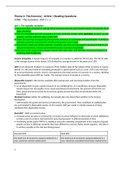Theme 2: The Economy - Article + Reading Questions
CORE - The Economy: Unit 1 + 2
Unit 1: The capitalist revolution
• Since the 1700s, increases in average living standards became a permanent feature of economic life in
many countries.
• This was associated with the emergence of a new economic system called capitalism, in which private
property, markets and firms play a major role.
• Under this new way of organizing the economy, advances in technology and specialization in products
and tasks raised the amount that could be produced in a day’s work.
• This process, which we call the capitalist revolution, has been accompanied by growing threats to our
natural environment, and by unprecedented global economic inequalities.
• Economics is the study of how people interact with each other, and with the natural environment, in
producing their livelihoods.
Income inequality: A handy measure of inequality in a country is called the 90/10 ratio. The 90/10 ratio
is the average income of the richest 10% divided the average income of the poorest of 10%.
GDP (Gross Domestic Product) is a measure of the market value of the output of the economy in a given
period. It is the total value of everything produced in a given period such as a year. GDP is also referred
to as Gross Domestic Income, since it corresponds to the total income of everyone in a country. Dividing
by the population gives GDP per capita - the average income of people in a country.
Disposable income is the income available after paying taxes and receiving transfers from the
government.
• Is our disposable income a good measure of our wellbeing?No, it is insufficient, because disposable
income leaves out: the quality of our social and physical environment, the amount of free time we
have, goods and services that we do not buy, goods and services that are produced within the
household.
Absolute income matters for wellbeing, but people also care about their position in the income
distribution.
GDP includes the goods and services produced by the government. They contribute to wellbeing but
are not included in disposable income. In this respect, GDP per capita is a better measure of living
standards than disposable income.
Real GDP = GDP at constant prices
• Constant prices are prices corrected for increases in prices (inflation) or decreases in prices (deflation)
so that a unit of currency represents the same buying power in different periods of time
• Purchasing power parity (PPP) is a statistical correction allowing comparisons of the amount of goods
people can buy in different countries that have different currencies.Parity means equality - the idea is
to achieve equality in the real purchasing power.
Nominal GDP Real GDP
the total sum of economic output produced in a the total sum of economic output produced in a
year valued at current market price year valued at a predetermined base market price
1
, does not take inflation into account inflation adjusted GDP
current market price base year’s market price
can be compared with various quarters of the can be compared with two or more financial
given year years
economic growth cannot be analysed easily a good indicator of economic growth
History’s hockey stick
• For a long time, living standards did not grow in any sustained way.
• When sustained growth occured, it began at different times in different countries, leading to vast
differences in living standards around the world.
Adam Smith
• wrote the most famous book in economics: ‘An Inquiry into the Nature and Causes of the Wealth of
Nations’ (1776)
• ‘A significant source of prosperity is the division of labour or specialization’
1.4 The permanent technological revolution
The Industrial Revolution is a wave of technological advances and organizational changes starting in
Britain in the eighteenth century, which transformed an agrarian and craft based economy into a
commercial and industrial economy.
• Remarkable scientific and technological advances occurred more or less at the same time as the
upward kink in the hockey stick in Britain in the middle of the eighteenth century.
In economics, technology is a process taking a set of materials and other inputs, including the work of
people and machines, to produce an output.
Technological process means a change in technology that reduces the amount of resources (labour,
machines, land, energy, time) required to produce a given amount of the output.
The process of innovation did not end with the Industrial Revolution. It has continued with the
application of new technologies in many industries. These broadly applicable technological innovations
give a particularly strong impetus (impuls) to growth in living standards because they change the way
that large parts of the economy work.
• By reducing the amount of work-time it takes to produce the things we need, technological changes
allowed significant increases in living standards.
1.6 Capitalism defined: private property, markets and firms
The capitalist revolution is the emergence in the eighteenth century and eventual global spread of a way
of organizing the economy that we now call capitalism.
Capitalism is an economic system characterized by a particular combination of institutions.
• Capitalism is an economic system in which private property, markets and firms play an important role.
• An economic system is a way of organizing the production and distribution of goods and services in an
entire economy by the institutions.
• Institution means the laws and social customs governing the way people interact in society.
2





